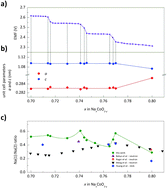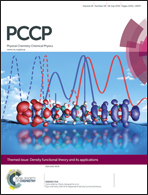Anomaly in the electronic structure of the NaxCoO2−y cathode as a source of its step-like discharge curve†
Abstract
In this paper we would like to show a new approach to an explanation of the nature of the discharge–charge curve of Na/Na+/NaxCoO2−y batteries, which can justify the existence of the step-like characteristics. This is still an open problem, which until now had no proper description in the literature. On the basis of comprehensive experimental studies of physicochemical properties of NaxCoO2−y cathode material (XRD, electrical conductivity, thermoelectric power, electronic specific heat) supported by calculations performed using the DFT method with accounting for chemical disorder, it has been shown that the observed step-like character of the discharge curve reflects the variation of the chemical potential of electrons (Fermi level) in the density of states of NaxCoO2−y, which is anomalously perturbed by the presence of the oxygen vacancy defects and sodium ordering. Our studies of structural, electronic and thermal properties of NaxCoO2−y cathode material as a function of concentration of electrochemically intercalated sodium document strong and step-like shift of the position of the Fermi level during introduction of electrons in this process. This effect is coherently supported by the shape of calculated density of states (DOS) of NaxCoO2−y having included oxygen defects and sodium ordering.


 Please wait while we load your content...
Please wait while we load your content...